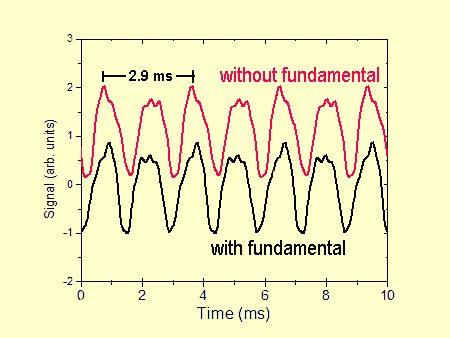

The signals from sustained tones can always be treated as a sum of sinusoidal functions (sines or cosines). For a sustained periodic signal, the frequencies of all of those sinusoids will be integer multiples of a lowest, or "fundamental" frequency. That is, they are harmonics of a common frequency. The higher frequency contributions, or "overtones," are what, for example, will make different musical instruments sound different.
To quantify pitches, which are a result of perception, one can define a "pitch number" by matching a tone to a sound generated by a sine wave generator (referred to as a "pure tone"), and then assigning the frequency of the sine wave to the tone.
Our hearing is such that in many cases the pitch (number) can be determined by hearing the overtones only. That is, the fundamental need not be present. Some refer to this by implying that our brains "fill in" the fundamental. However, a simple frequency counter will often do the same thing. This is because a sound consisting of only harmonic overtones (i.e. harmonics except for the 1st harmonic) will be periodic in time with a period corresponding to the fundamental. Many frequency counters will use a signal's zero crossing, or a similar repeating feature, to determine the period of oscillation. The fundamental need not be present in such a case as well. There is nothing particularly intellectual about it.
Here is a graph of a tenor singing the F just above middle C as recorded and processed to completely remove the fundamental. (The fundamental was weak in the original). A frequency counter which was sensitive to the peak in the signal would agree withe listener.

|
Listen - With Fundamental (mp3) |
| Listen - Without Fundamental (mp3) |
In some music, orchestration can be used to achieve a similar effect. In audio processing, frequencies too low for the equipment can be "simulated" using an appropriate combination of overtones. For efficient sound transmission such as in some telephone lines and radio communications, the lower frequencies might be omitted, leaving them for the listener to fill them in. Some bass instruments can play notes too low to hear. For example, contrabassoons can easily play at a frequency below that which can be heard, but those lowest tones are perceived by the overtones which are heard.
Questions/Comments to: suits@mtu.edu
There are no pop-ups or ads of any kind on these pages. If you are seeing them, they are being added by a third party without the consent of the author.
Back to Physics of Music page